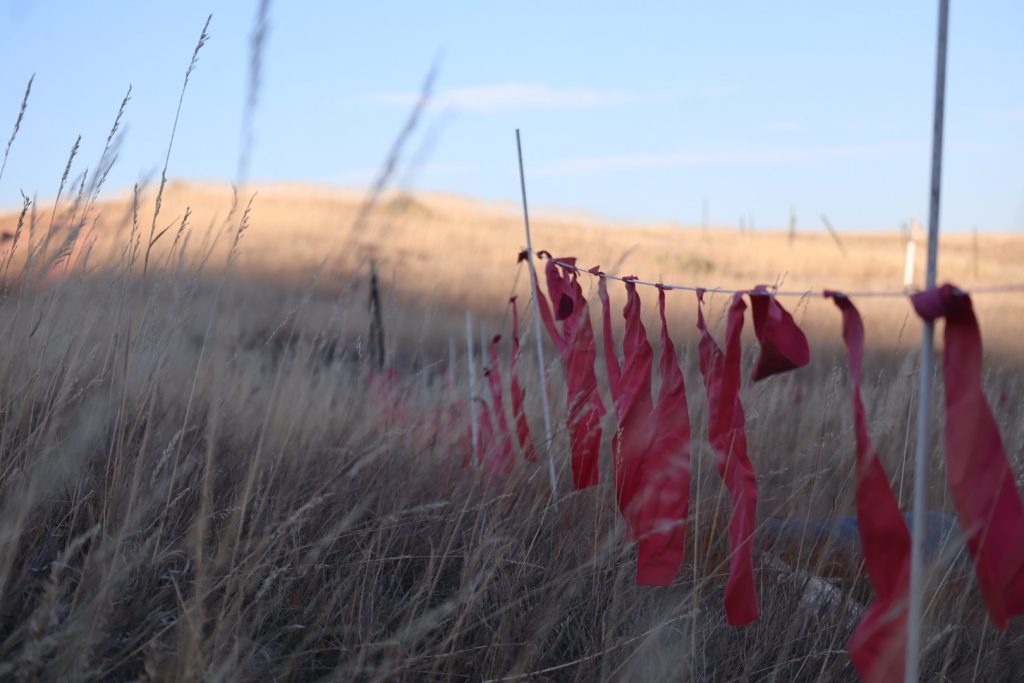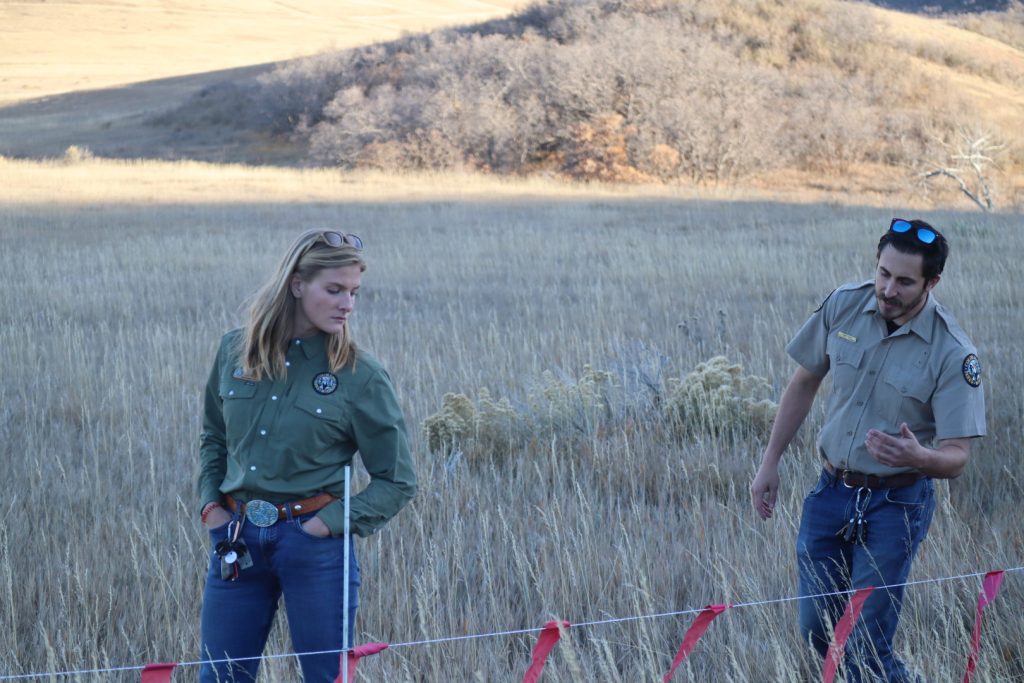See how Colorado Parks and Wildlife is working to minimize wolf conflicts on ranch land
Description
From riders on horseback surveying the landscape to electric barriers to ward off prey, Colorado Parks and Wildlife is deploying a slew of tactics to prevent and reduce conflicts with wolves as it continues its multi-year reintroduction of the species.
The efforts come as Parks and Wildlife enters the third year of the state’s wolf reintroduction program, which began in late 2023 after Colorao voters approved the program the year prior. To date, the agency has released 25 wolves in western Colorado, which has led to the formation of four dens, at least 10 new pups and 11 confirmed wolf deaths.
Agency officials invited reporters on Thursday to a live demonstration of its conflict minimization tools, some of which have been deployed in the field. They also provide updated figures on the number of strategies implemented and the increase in staff capacity since the reintroduction program began in late 2023.
Nestled in the tranquil grasslands on the edge of Roxborough State Park less than 40 miles south of Denver, Parks and Wildlife walked reporters through various staged areas to showcase what their tools look like and how they work.
Officials also stressed that their strategies are often situational and depend on numerous factors, from geography and the nature of the wolf activity to what works best for the producer.
Some strategies have yet to be used in the wild, while others are just getting going as the agency scales its wolf operations. The agency has around 140 staff ready to respond to wolf-related incidents and a plethora of tactics at its disposal.
One of the most seemingly simple, yet effective, tools is fladry, which involves tying a line of interspersed flags — often red in color — around a perimeter. The red flags flapping in the wind can trigger an innate fear and avoidance in wolves. That fear response can be reinforced when the fladry is electrified.
Fladry has been deployed at 19 sites, with “zero depredations inside fladry enclosures,” according to Adam Baca, the state’s first-ever wolf conflict coordinator.
Baca acknowledged there’s been skepticism around using fladry as an effective deterrent. To a human, the thin line carrying flapping flags looks more like a car sales lot than an intimidating barrier.
“You’re telling me this is going to keep wolves out?” Baca joked.
But if you “implement correctly, there’s really good odds of success,” he said.
Baca said it’s up to a rancher to decide if they want to try it on their property. Like any tool, fladry does have its drawbacks. The barrier is more suited to smaller areas, and is ideal for temporary usage of around 45 to 90 days.
It also needs regular vigilance to be maintained, and snow-covered or frozen ground can make driving the stakes in to form the barrier particularly difficult, meaning extra machinery may be required.
<figure class="wp-block-image size-large">
 <figcaption class="wp-element-caption">Fladry is set up by Colorado Parks and Wildlife staff on a grassy plain on the edge of Roxborough State Park on Thursday, Nov. 6. The barrier helps deter wolves from livestock.</figcaption><figcaption>Robert Tann/Summit Daily News</figcaption>
<figcaption class="wp-element-caption">Fladry is set up by Colorado Parks and Wildlife staff on a grassy plain on the edge of Roxborough State Park on Thursday, Nov. 6. The barrier helps deter wolves from livestock.</figcaption><figcaption>Robert Tann/Summit Daily News</figcaption>Another key strategy being deployed by Parks and Wildlife is range riding to scout the landscape. The practice can help detect injured, dead or sick animals, and can also be used to pick up on early signs of predator activity and where preventive efforts may need to happen.
While range riding typically conjures the image of scouts on horseback, riders have also traversed the landscape in ATVs, trucks or on foot. Parks and Wildlife have also utilized drones for aerial surveillance to supplement their on-the-ground activities. They also carry non-lethal “hazing” tools to scare off predators during any encounters.
The state currently employs two-full time range riders and eight contracted seasonal employees across Parks and Wildlife and the Colorado Department of Agriculture. The program, which launched this year, was one of the most anticipated and long-awaited of Parks and Wildlife’s wolf mitigation strategies.
Jesse Lasater, who comes from a family of sheep farmers and is one of the state’s two dedicated range riders, said a critical aspect of the program is the communication between the state and ranchers.
When range riders show up to a location, they’ll have a text thread between themselves and other Parks and Wildlife and department of agriculture staff, as well as the ranchers, to provide regular updates.
“Everyone’s updated daily,” Lasater said, “and so when you hit the ground and show up, you already know what has happened (during) the previous days and you know what can be expected to look for. And so that communication is really helpful.”
<figure class="wp-block-image size-large">
 <figcaption class="wp-element-caption">Colorado Parks and Wildlife Damage Specialist Lauren Emerick and Wolf Conflict Coordinator Adam Baca inspect a line of fladry on Thursday, Nov. 6. Parks and Wildlife staff hosted reporters to showcase how some of their wolf conflict minimization tools work in the field.</figcaption><figcaption>Robert Tann/Summit Daily News</figcaption>
<figcaption class="wp-element-caption">Colorado Parks and Wildlife Damage Specialist Lauren Emerick and Wolf Conflict Coordinator Adam Baca inspect a line of fladry on Thursday, Nov. 6. Parks and Wildlife staff hosted reporters to showcase how some of their wolf conflict minimization tools work in the field.</figcaption><figcaption>Robert Tann/Summit Daily News</figcaption>Along with range riding, another important wolf deterrent is proper carcass management. Shelby Neiberger, the state’s other dedicated range rider, showed how an electric bear fence — often used to protect tents in the wilderness — can also be used for carcass protection.
Neiberger said the fences can be found at many outdoor stores, and, coupled with a tarp covering the dead animal, can prevent predators, like wolves, from being attracted to livestock.
If wolves do begin to enter onto a ranch’s property, hazing is one way to deter the animals. Parks and Wildlife considered two types of hazing: non-injurous and injurious.
Non-injurous hazing can include chasing and yelling at a wolf, or even shooting near but not at it, to ward it off. This type of activity involves no physical contact, and no permit is needed for someone to engage in this type of hazing.
Injurious hazing may involve physical attacks like shooting rubber bullets, bean bag rounds or paintballs at the wolf. This type of response requires a permit from Parks and Wildlife.
Standing in a grassy field as the late afternoon sun fell behind the rolling hills behind her, Lauren Emerick, a wildlife damage specialist for Colorado Parks and Wildlife, demonstrated shooting pellets from a bright yellow gun that is “similar to a paintball gun.”
<figure class="wp-block-image size-large">




